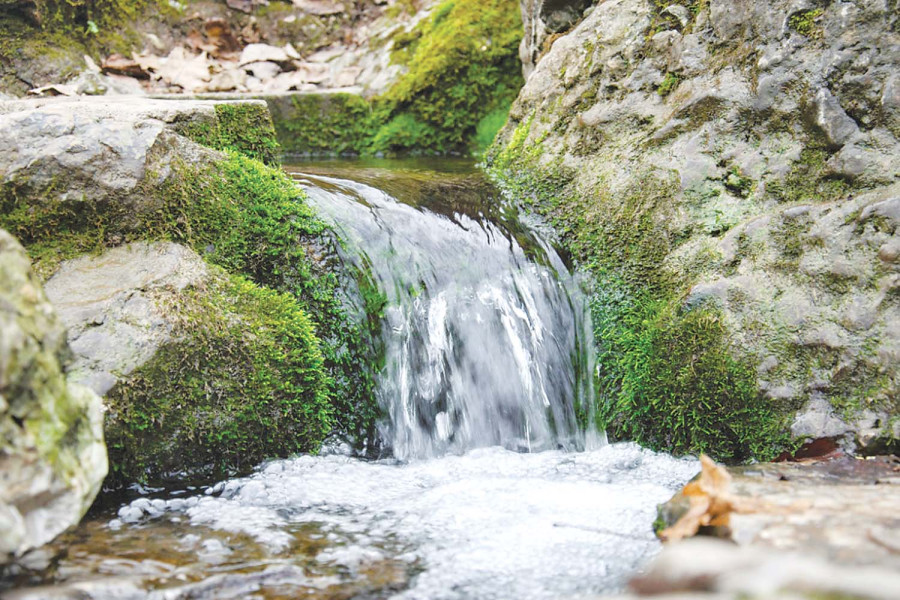Columns
Nepal’s worsening water crisis
We must recalibrate our efforts to restore depleting water sources.
Madhukar Upadhya
The water crisis in the Nepal Himalayas is no longer looming: It’s already underway. Despite over two decades of consistent reports of drying springs and streams across the mountains, we didn’t have any idea about why this was happening to these local water sources. Our limited understanding was based on anecdotes. We naively believed that road construction and deforestation in the mountains were to blame and that stopping haphazard roadworks, greening the mountains and applying rainwater harvesting methods would sufficiently help restore these water sources. However, when Bhutan, which boasts of maintaining over 60 percent forest cover and hasn’t arbitrarily constructed roads through its mountains as we have, reported that over 25 percent of the surveyed springs were drying up, the reasons for declining local water sources became more elusive.
Watershed experts began suspecting that perhaps a change was occurring in the region on a Himalayan scale, which was poorly understood. But it appears that we finally have some explanation on the progressive depletion of water sources, both in the mountains and the Tarai and what it might mean for our water security in the coming years.
Declining soil moisture
According to a recent global study conducted by a team of researchers from the University of Texas and the Global Institute for Water Security, the rising atmospheric and ocean temperatures over the decades have substantially altered terrestrial water circulation including precipitation, evaporation, evapotranspiration and surface water flow resulting in a large-scale decline in soil moisture across most continents. The global soil moisture decline became more pronounced in 2000 and has continued on its downward trajectory ever since, without any sign of recovery, indicating that soil moisture is unlikely to improve naturally with the ever-increasing global temperatures. The soil moisture has declined at an alarming scale, with a reduction of about 2,623 gigatonnes between 2000 and 2016, roughly about 40 percent of the combined ice lost from Antarctica and Greenland during the same period. Sadly, the shift in the global water cycle appears to be irreversible and is likely to be permanent as the warming continues; the lasting consequences are nebulous and, thus, deeply concerning.
At home, when we began observing retreating glaciers and expanding glacial lakes in the Himalayas, it caught—and continues to catch—the attention of policymakers in highly prioritising climate change. Conversely, the other startling scenario, particularly the drought-like conditions increasingly developing at lower altitudes, didn’t draw as much policy attention because these incidents weren’t as evident as the snow melt. Increasing rockslides in ridge areas were signs of moisture loss along higher altitudes.
The uniqueness of the Himalayas lies in it being at the lower latitude running east-west and experiencing a shifting of the timberline downslope with increasing droughts not seen on other mountain ranges such as the Hengduan Mountains in China. At lower altitudes in the middle hills, the Chir Pine, a xeric plant species, started colonising abandoned rice-growing terraces after they became dry. The expanding glacial lakes and retreating glaciers overshadowed the emerging evidence of declining soil moisture in the hills and mountains, which became apparent only when the disappearing water sources began affecting local livelihoods.
The climate survey conducted by the National Statistics Office (NSO) revealed how widespread droughts have been hitting Nepal’s agriculture the hardest. People abandoning their villages in the face of drying water sources have become a commonly reported phenomenon over the last 20 odd years. Yet, the government’s national plans don’t acknowledge droughts and diseases as the major hurdles to agricultural development. The recently prepared 16th periodic plan (2024/25-2028/29) fails to connect how progressively depleting water sources have impacted livelihoods and have become a significant development hurdle. This is despite the climate change survey reiterating that an average of 43 percent of households across the country reported streams being completely dry and 38 percent observed the complete drying of springs. It’s worth noting that the hills have lost more springs than the mountains.
What is going on
We don’t know to what extent soil moisture will decline. If it’s truly irreversible, as suggested by the current study, the decline won’t be limited to springs and small streams, possibly extending to other larger sources such as lakes and small rivers, with long-lasting consequences affecting overall ecosystem resilience. The implications could be manifold, from food production to increased costs of water availability for domestic use, escalation of wildfires and rise in diseases, among others. We aren’t remotely prepared for these eventualities.
Up against the current climate transition, researchers noted that soil moisture is unlikely to recover during the rain following a drought, as it used to in the past, due to warmer conditions. Besides, rainfall patterns have also changed. The current pattern of high-intensity short-duration rain mostly flows out as runoff without replenishing soil moisture as required.
The need for an efficient rain-water management strategy cannot be overstated. A blanket approach of time-bound, project-based soil moisture recharge initiatives will no longer suffice. The variability of local precipitation in the diverse geological settings across the country requires area-specific remedies. What works for the dry areas of Panchthar may not necessarily work for the dry areas of Sindhuli. Therefore, a prerequisite to any efforts to restore soil water is a better understanding of the problem, without which, it will be challenging to plan for effective remedies.
Additionally, there’s a need to question our prevailing perceptions, too. Deforestation of the Chure, for example, has been blamed for falling aquifer levels in the Tarai, which is largely based on an unsubstantiated understanding of local hydrogeology: More forest cover doesn’t necessarily translate to more water reserves.
Extraordinary times
We must bear in mind that we aren’t only operating in a progressively warming world, with an increased likelihood of frequent extreme weather events, but also one where the required collective action to address the climate crisis is dwindling. Given the current geopolitical tensions and the implementation of more trade restrictions and tariffs which indicates a growing global emphasis on geoeconomics, the prospects of cutting carbon emissions, especially by the big emitters to mitigating the crisis seem to be diminishing.
The message is loud and clear. We must recalibrate our efforts to restore depleting water sources. For this, we require a transformative approach. The periodic plans and methods adopted must do away with the traditional template and factor in the massive shift that society and the environment are undergoing. Our actions must keep pace with the change, lest we flounder further.




 31.12°C Kathmandu
31.12°C Kathmandu















